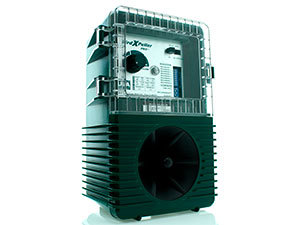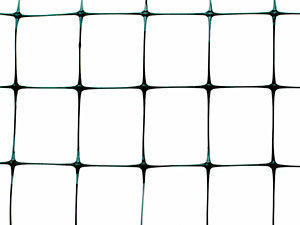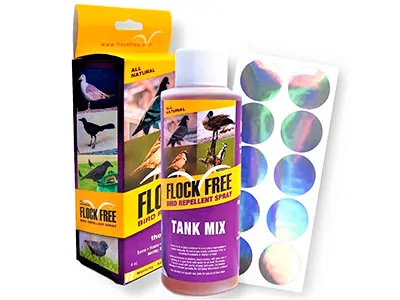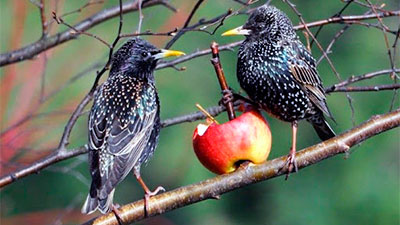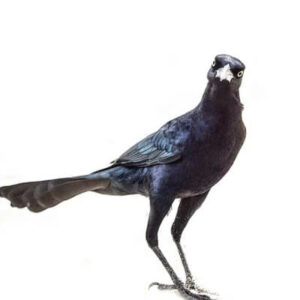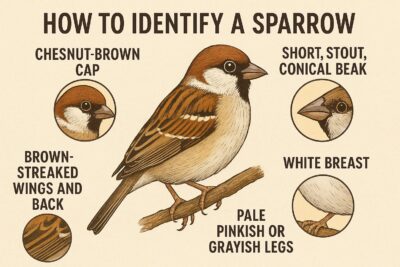Woodpeckers can be a real nuisance for many homeowners. These birds create problems primarily by pecking holes in trees and wooden structures. While tree damage might be tolerable in some cases, damage to your wooden house siding or trim can quickly become a serious issue. Woodpeckers peck for two main reasons: to mark their territory and to search for food. In this comprehensive guide, we’ll explore effective, humane methods how to get rid of woodpeckers and protect your property.
How to Get Rid of Woodpeckers: Top Deterrents

Best Sound Deterrent

Best Physical Barrier

Best Visual Deterrent
- 3 Humane Steps on How To Get Rid of Woodpeckers Fast
- How to Kill: Is It Safe to Use a Woodpecker Poison?
- Best Woodpecker Deterrents by Category
- Woodpeckers: General Characteristics, Distribution and Habitat
- Integrated Approach to Woodpecker Control
- Conclusion
- Frequently Asked Questions About Woodpecker Control
3 Humane Steps on How To Get Rid of Woodpeckers Fast
All problems with woodpeckers can be prevented if you implement these effective solutions that will help you eliminate these noisy birds. Here are 3 simple but effective steps to control woodpeckers and prevent damage to your property.
-
Effective Method of Woodpeckers’ Exclusion: Net Them Off
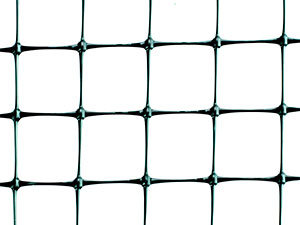
Visual deterrents are a good first line of defense to keep woodpeckers away. However, when these products prove insufficient, you’ll need more drastic measures – like netting. Woodpecker netting can be installed on the side of a structure to act as a physical barrier, blocking noisy woodpeckers from pecking.
Placing lightweight plastic netting is one of the most cost-effective methods of excluding woodpeckers. A mesh of 3/4 inch is generally recommended. Make sure to leave at least 3 inches of space between the building and the netting so that woodpeckers cannot cause damage through the mesh.
Netting is a 100% effective way to keep woodpeckers off your property. -
Excellent Pest Control: Ultrasonic Deterrents
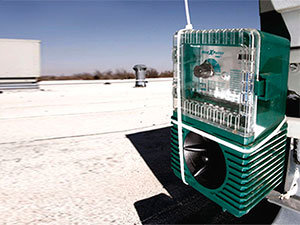
While repellent sprays can help control woodpeckers, sound devices often prove more effective. Recommended options include Bird-X BirdXPeller PRO and Bird B Gone Bird Chase Super Sonic Deterrent, which use recorded predator and distress calls to frighten woodpeckers away from your property.
Woodpecker repellers work especially well when combined with placing visual deterrents like Bird Scare Tape directly on areas the woodpeckers are pecking. -
Stop Woodpeckers From Returning: Visual Deterrents
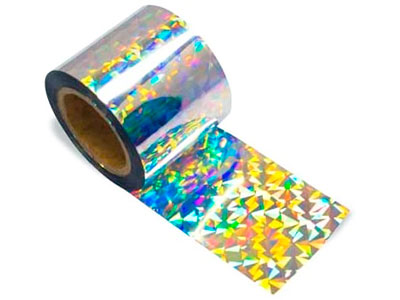
Scare tactics are crucial for effective woodpecker control. These birds become frightened or confused when they encounter certain deterrents and will avoid treated areas. Visual deterrents such as shiny reflective objects, balloons, and diverters can be hung in front of locations where pecking has occurred to prevent woodpeckers from returning.
Top recommended visual deterrents include Bird Scare Tape, Bird B Gone Woodpecker Deterrent Kit, and Bird B Gone Reflective Scare Bird Diverter.
Follow these tips to make your property less inviting to woodpeckers and prevent costly damage.
How to Kill: Is It Safe to Use a Woodpecker Poison?
Important Legal Information
There are no poisons specifically labeled for woodpeckers, as these birds are federally protected migratory birds. You cannot legally kill, poison, shoot, or capture woodpeckers without a special permit.
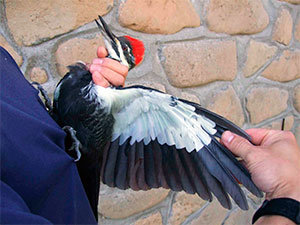 Woodpeckers are protected by both state and federal laws. This means that attempting to kill these birds is not only illegal but also unethical.
Woodpeckers are protected by both state and federal laws. This means that attempting to kill these birds is not only illegal but also unethical.
Woodpeckers are beneficial to the ecosystem and their elimination should only be done legally and safely. We strongly advise against using poisons, as they can cause secondary or accidental poisoning of humans, pets, and other wildlife.
Rather than seeking to harm these birds, use the humane deterrent products mentioned in this article to prevent woodpecker damage to your property. These products, such as reflective tape, decoys, or sound devices, can create an unwelcoming environment for woodpeckers without causing them harm. Additionally, exploring resources that explain how to deter grackles effectively can further enhance your efforts in protecting your property from unwanted bird activities. By employing these humane strategies, you can maintain a peaceful coexistence with wildlife while preserving the integrity of your home.
Best Woodpecker Deterrents by Category
Sound Deterrents
Sound-based deterrents work by broadcasting predator calls or woodpecker distress signals that frighten the birds away from your property. These devices are highly effective, especially for large areas.
Bird-X BirdXPeller PRO Version WP
Best Sound DeterrentHow Does It Work
How to Use
- Mount the device 5-10 feet above the ground, facing the problem area
- Program the device using the control panel to set volume, sound patterns, and timing
- Adjust settings to activate during daylight hours when woodpeckers are most active
- For best results, move the device occasionally to prevent birds from becoming accustomed to it
- Covers up to 1 acre of property
- Fully programmable - control volume, sounds, intervals, day/night operation
- NEMA type box designed to withstand outdoor use
- Humane solution that doesn't harm birds
- Requires power source or battery replacement
- May initially disturb other wildlife or pets
- Takes time to achieve full effectiveness
Other Sound Deterrent Options
Bird B Gone Bird Chase Super Sonic Deterrent is another effective sound device that broadcasts predator and distress calls every 10 minutes. It works on similar principles as the BirdXPeller PRO but with slightly different programming options and coverage area.
Physical Barriers
Physical barriers provide a 100% effective solution when properly installed. They physically prevent woodpeckers from accessing and damaging your property’s wooden surfaces.
Bird-X Standard Bird Netting
Best Physical BarrierHow Does It Work
How to Use
- Measure the area to be protected and cut netting to size, allowing extra material for secure attachment
- Install mounting hardware around the perimeter of the area to be protected
- Secure the netting to the mounting hardware, ensuring it's taut but has about 3 inches of space from the surface
- Check periodically for tears or sagging and repair as needed
- 100% effective when properly installed
- Covers up to 630 square feet
- 5/8″ polypropylene mesh is durable and weather-resistant
- Blocks all birds and other unwanted animals
- Requires proper installation to be effective
- May be visually noticeable on homes
- Requires periodic maintenance to check for damage
Other Physical Barrier Options
For heavy-duty applications, consider Bird-X Structural Heavy Duty Bird Netting, which offers enhanced durability for high-traffic areas or locations with persistent woodpecker problems. Anti-Woodpecker Polycarbonate Strips are another option that provides a hard surface woodpeckers cannot penetrate, combined with an unpleasant odor that further deters the birds.
Visual Deterrents
Visual deterrents work by creating visual disturbances that frighten or confuse woodpeckers, causing them to avoid the treated area. These are often the most affordable and easiest to implement woodpecker control measures.
Bird Scare Tape
Best Visual DeterrentHow Does It Work
How to Use
- Cut strips of tape approximately 2-3 feet long
- Attach one end of each strip to areas where woodpeckers have been active
- Allow the strips to hang freely so they can move in the wind
- Space strips every 3-6 feet along affected areas
- Replace when tape becomes worn or loses its reflectivity
- Affordable and easy to install - no special tools required
- Weather-resistant and long-lasting
- No maintenance required once installed
- Can be quickly applied to respond to new problem areas
- Less effective in areas with minimal wind
- May lose effectiveness over time as birds become accustomed
- Needs replacement when reflectivity diminishes
Other Visual Deterrent Options
Bird B Gone Woodpecker Deterrent Kit combines multiple visual deterrents including a scare balloon, flash tape, and mounting hardware for a comprehensive approach. Bird B Gone Reflective Scare Bird Diverters use shiny, reflective surfaces and predator eye patterns to create an optical illusion that confuses and frightens woodpeckers.
Chemical Deterrents and Repellents
Chemical deterrents use taste and smell to make areas unpleasant for woodpeckers, discouraging them from returning to treated surfaces. These products are ideal for protecting specific wooden surfaces.
Flock Free Bird Repellent Spray
Best Chemical DeterrentHow Does It Work
How to Use
- Clean the surface thoroughly before application
- Dilute the concentrate according to package directions
- Apply using a garden sprayer to surfaces woodpeckers target
- Allow to dry completely before rain exposure
- Reapply every 30-60 days or after heavy rain
- For best results, combine with visual deterrents
- All-natural ingredients make it safe for use around people and pets
- Non-toxic and environmentally friendly
- Long-lasting protection that activates when needed
- Can be applied to various surfaces including wood, metal, and stone
- Requires proper protective equipment during application
- Strong scent during application process
- Needs periodic reapplication for continued effectiveness
- Works best as part of an integrated control approach
When using Flock Free Bird Repellent Spray, wear protective gloves. Avoid touching the liquid. Although the spray is safe for general use, the deterrent scent will remain on the skin and may be difficult to remove.
When using the spray in a poorly ventilated area, be sure to wear a respirator mask.
Other Chemical Deterrent Options
Woodpecker Deterrent Paint Additive can be mixed with exterior paints or stains to incorporate repellent properties directly into your home’s finish. This provides long-lasting protection that activates when woodpeckers attempt to peck the surface.
Woodpeckers: General Characteristics, Distribution and Habitat
The woodpeckers belong to the family Picidae, with members found worldwide except in New Zealand, New Guinea, Australia, Madagascar, and extreme polar regions. In the United States alone, 21 different woodpecker species can be found.
Physical Characteristics
Woodpeckers have distinctive features including sticky long tongues for extracting food, long and sharp bills for drilling and drumming on trees, short legs, and stiff tail feathers that serve as a supportive prop. Most male woodpecker species have prominent yellow or red head markings.
Habitat & Distribution
Woodpeckers are highly adaptable birds that occupy various habitats including rainforests, savannahs, woodlands, scrublands, and bamboo forests. They are most commonly found in areas with at least some trees present, though some species can spend part of their time feeding on the ground.
Diet & Ecological Role
Woodpeckers primarily eat insects extracted from living and dead trees, along with nuts, fruits, and tree sap. They play a crucial ecological role by keeping trees healthy and protecting them from insect infestations.
Breeding Habits
Woodpeckers nest in cavities – usually in tree trunks or large branches. Unfortunately, they may also excavate nest holes in commercial and residential structures, which is where the problems for homeowners begin. Most woodpecker species excavate one hole per breeding season. A typical nest contains 3-5 eggs which are incubated for about 2 weeks before the chicks hatch.

Understanding Woodpecker Damage
The problem of woodpecker damage to buildings can be significant in certain regions. Buildings with wood exteriors in rural wooded settings or in suburbs near wooded areas are most susceptible to hole and pecking damage. Usually, damage to a building involves only 1 or 2 birds, but it may involve up to 6 or 8 during a single season.
Woodpeckers can be particularly destructive to vacation or summer homes that are vacant during part of the year, as the damage often goes unnoticed until it becomes severe.
Most woodpecker damage occurs from February through June, corresponding with territory establishment and breeding season. This is when prevention efforts are most important!
The two main woodpecker problems property owners face are noise disturbance and physical damage. These birds are known to drill into wooden sheds, siding, fences, and decks as well as some non-wooden objects. Woodpeckers can hammer away persistently for hours, creating both structural damage and significant noise disturbance.
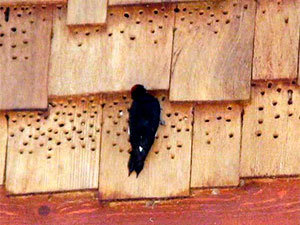
Integrated Approach to Woodpecker Control
For the most effective results, we recommend combining multiple deterrent methods. Here’s a strategic approach to woodpecker control:
- Identify problem areas – Monitor your property to determine where woodpeckers are causing damage
- Start with visual deterrents – Apply Bird Scare Tape or reflective diverters to affected areas
- Add sound deterrents – Install a device like the BirdXPeller PRO to cover a wider area
- Apply physical barriers – Use netting for areas with persistent problems
- Treat surfaces – Consider chemical deterrents for finishing touches
This multi-layered approach creates several lines of defense against woodpecker damage and significantly increases your chances of success.
Conclusion
What is the best woodpecker control product? That depends largely on your specific situation and needs. The most effective approach combines multiple deterrent strategies – such as visual deterrents, sound devices, and physical barriers – to protect your property from woodpecker damage without harming these beneficial birds.
Remember that woodpeckers are protected birds, and humane deterrent methods are the only legal and ethical approach to controlling them. For the most persistent woodpecker problems, consider the Bird-X BirdXPeller PRO as our top sound deterrent, with Bird-X Standard Bird Netting as an extremely effective physical barrier when properly installed. For those on a budget, Bird Scare Tape provides an affordable yet useful first line of defense.
By understanding woodpecker behavior and implementing these humane control strategies, you can effectively protect your property while respecting wildlife conservation laws.
Frequently Asked Questions About Woodpecker Control
Are woodpeckers protected by law?
Yes, woodpeckers are federally protected migratory birds under the Migratory Bird Treaty Act in the United States. This means it is illegal to kill, harm, capture, or possess woodpeckers without a special permit from the U.S. Fish and Wildlife Service.
The protection extends to their nests and eggs as well. Violating these protections can result in significant fines and penalties, which is why humane deterrent methods are the only legal approach to woodpecker control.
Why do woodpeckers peck on houses?
Woodpeckers peck on houses for three primary reasons:
- Foraging for food – They may detect insects living in the wood of your home, particularly if you have a termite or carpenter bee infestation
- Territorial drumming – Woodpeckers drum to establish territory and attract mates, and your home’s wood surfaces may create satisfying resonance
- Nest building – During breeding season (February to June), woodpeckers excavate nest cavities in trees or wooden structures
Understanding the reason for pecking can help you choose the most effective deterrent method.
When is woodpecker damage most likely to occur?
Most woodpecker damage occurs from February through June, which corresponds with their breeding season and territory establishment period. This is when woodpeckers are most active and aggressive in their pecking behaviors.
Damage is particularly common in early spring when males establish territories and attract mates through drumming. Implementing deterrents before this period can help prevent damage before it starts.
How do I know if I have woodpeckers or other pests?
Woodpecker damage has distinctive characteristics:
- Neat, round holes approximately 1-3 inches in diameter for nesting
- Horizontal or vertical rows of small holes for feeding
- Irregular, shallow holes and damage from drumming
- Damage often occurs on the same wall or area repeatedly
- You may hear loud, rhythmic tapping especially in early morning hours
Other wood-damaging pests like carpenter bees leave smaller, perfectly round entrance holes with sawdust below, while termites typically don’t create visible external holes.
Can I repair woodpecker damage myself?
Yes, you can repair minor woodpecker damage yourself. For small holes and superficial damage:
- Clean the damaged area thoroughly
- Fill holes with wood putty or wood filler
- Sand the area smooth once dry
- Prime and paint to match your home’s exterior
- Apply a woodpecker deterrent to prevent future damage
For extensive structural damage, especially if the birds have created deep cavities, it’s best to consult a professional contractor who can properly assess and repair the damage.
How effective are fake owls at deterring woodpeckers?
Fake owls and other predator decoys have limited effectiveness against woodpeckers. They may work initially, but woodpeckers quickly become habituated to stationary decoys when they realize there’s no actual threat.
To improve effectiveness, regularly move the decoy to different locations and combine it with other deterrent methods such as reflective tape or sound devices. Some newer decoys with moving parts or those activated by motion sensors tend to be more effective than stationary models.
Will treating my house for insects help with woodpecker problems?
Yes, treating your house for insects can significantly help with woodpecker problems if the birds are pecking to find food. If woodpeckers are targeting your home to feed on insects like carpenter bees, termites, or ants living in the wood, eliminating these insects removes the food incentive.
Have a professional pest control company inspect your home for insect infestations, particularly in areas where woodpeckers are active. Treating the underlying insect problem can be a crucial part of a comprehensive woodpecker management strategy.
What should I do if I find a woodpecker nest in my house?
If you find an active woodpecker nest in your house with eggs or young birds present, you should leave it undisturbed until the young have fledged, as disturbing an active nest violates federal protection laws. Once the nest is abandoned after the breeding season:
- Seal the entrance hole with wood putty or a wood patch
- Repair any surrounding damage
- Install deterrents to prevent future nesting
- Consider installing netting over the area
If the situation is causing significant property damage, contact your local wildlife authority about possible special permits for nest removal.
How long do woodpecker deterrents typically last?
The effectiveness and longevity of woodpecker deterrents vary by type:
- Visual deterrents (reflective tape, scare devices): 3-6 months before needing replacement or repositioning as birds may become habituated
- Sound deterrents: Can remain effective for years if the devices are maintained and periodically moved
- Physical barriers (netting): 2-5 years depending on weather exposure and material quality
- Chemical repellents: Typically need reapplication every 30-90 days or after heavy rain
For optimal protection, use multiple deterrent types simultaneously and rotate or refresh them periodically.
Can woodpeckers damage my home’s insulation?
Yes, woodpeckers can damage your home’s insulation if they create holes deep enough to penetrate through the exterior siding or trim. This damage can lead to several problems:
- Reduced energy efficiency and increased utility bills
- Moisture intrusion leading to mold or rot
- Entry points for other pests like insects or rodents
- Structural weakening if damage is extensive and left unrepaired
It’s important to address woodpecker damage promptly to prevent these secondary issues from developing.
